Understanding Wasps: Aggression and Ecology


Intro
Wasps are complex creatures that often evoke strong reactions in humans due to their aggressive behavior. Understanding this behavior requires a comprehensive approach. It involves delving into their ecological roles and the various factors that trigger aggression. In addition, dissecting the common myths surrounding wasps will help clarify misconceptions and foster a better understanding of these insects.
This article will address the intricate world of wasps, specifically within woodland ecosystems. By examining their interactions within these environments, we can shed light on their significance and the impact they have on biodiversity. Furthermore, we will explore effective management strategies that could mitigate negative encounters with wasps while respecting their ecological contributions.
Understanding Woodland Ecosystems
Importance of Biodiversity in Forests
Woodland ecosystems are vital for sustaining high biodiversity. Wasps play a significant role in controlling pest populations and pollinating plants. Their presence helps maintain a balance within these ecosystems. A healthy population of wasps indicates a thriving environment, fostering other species, including various insects, birds, and mammals.
Role of Forests in Climate Regulation
Forests do not merely serve as habitats; they also contribute to climate regulation. Through photosynthesis, they absorb carbon dioxide and release oxygen. This process helps mitigate climate change by reducing greenhouse gas concentrations in the atmosphere. Wasps, as opportunistic hunters and pollinators, contribute to the overall health of forest flora, which in turn supports climate stability.
Myths and Realities of Wasp Behavior
There are several misconceptions surrounding wasps. One common myth is that all wasps are aggressive and will sting unnecessarily. In reality, most wasp species are non-aggressive and only sting in self-defense or when provoked. Understanding their true behavior is crucial for coexistence.
Effective Management Strategies
To address potential issues with wasps, it is important to implement management strategies that reduce the likelihood of negative encounters. These strategies should be informed by an understanding of wasp behavior and ecology.
- Avoidance: Educating people about wasp behavior can reduce unnecessary fear and negative interactions.
- Natural Predators: Encourage the presence of natural predators to manage wasp populations.
- Non-lethal Control: Use traps and other non-lethal methods to deter wasps without harming them.
"Understanding the ecological role of wasps can shift perceptions and promote coexistence rather than conflict between humans and these insects."
Prelude to Wasps
Understanding wasps is crucial for anyone who spends time outdoors or works in fields related to agriculture and forestry. Wasps play significant roles in the ecosystem, serving both as predators and pollinators. Their behavior, especially aggressive tendencies, warrants attention due to impacts on human activities and well-being. By recognizing their ecological importance, we can make informed decisions to coexist more peacefully with these insects.
Defining Wasps
Wasps are members of the order Hymenoptera, which includes bees, ants, and other similar insects. They are characterized by their slender bodies, narrow waists, and typically more elongated wings compared to bees. Unlike bees, most wasps do not possess fuzzy bodies covered in hairs and lack the adaptations for gathering pollen. Wasps can generally be divided into two main categories: solitary wasps, which live and hunt alone, and social wasps, which live in colonies. Social wasps, like yellowjackets and hornets, are particularly notable for their complex social structures and aggressive behavior, especially in defense of their nests.
Diversity of Wasp Species
Wasps exhibit a vast diversity in terms of species, behavior, and habitat. It is estimated that there are over 75,000 described species of wasps, ranging from the well-known paper wasps to the more obscure parasitic wasps. Their habitats vary greatly, including wooded areas, gardens, and urban environments.
Some species, such as the European hornet, are more prevalent in certain regions and are recognized for their distinctive coloration and size. Meanwhile, solitary wasps, like mud daubers, help control pest populations by preying on insects. The diversity of wasp species means that their roles in various ecosystems can be quite different, further underlining the importance of understanding their behavior and habitat preferences.
"Understanding wasp species diversity allows us to appreciate their roles as natural pest controllers and pollinators."
Behavioral Traits of Wasps
Understanding the behavioral traits of wasps is crucial for several reasons. These traits not only influence their ecological roles but also help in managing human-wasp interactions effectively. Wasps exhibit a range of behaviors that are essential for their survival and for maintaining ecological balance. By studying these behaviors, forestry professionals and academics can better appreciate the complexities of these insects. Moreover, this knowledge fosters a respectful coexistence with wasps, which is vital in preserving biodiversity in woodland ecosystems.
Examining Aggression
Wasp aggression is often a misunderstood aspect of their behavior. Generally, their aggressive tendencies are defensive rather than predatory. Wasps possess a venomous sting, which they use primarily to protect themselves and their nests. This is particularly evident during the breeding season when the wasps are more protective of their young.
Factors influencing aggression include:
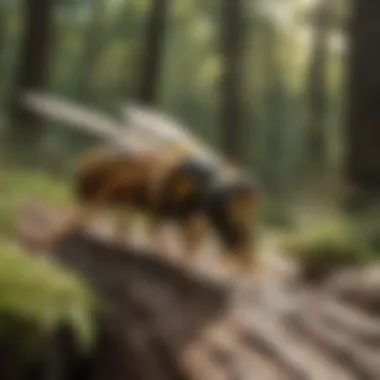
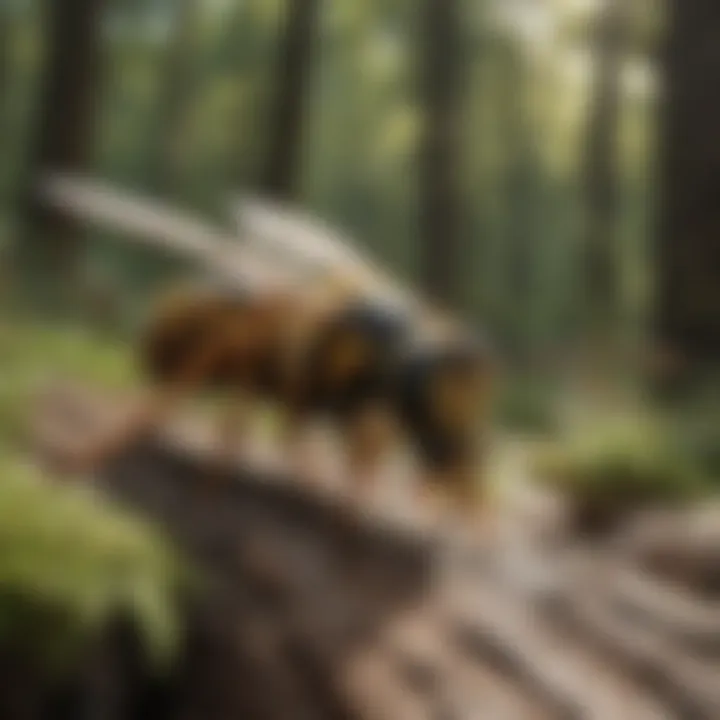
- Nest disturbance: Approaching a nest can trigger defensive behavior. If a wasp perceives a threat, it may become aggressive to defend its territory.
- Environmental stress: Wasps may exhibit increased aggression due to extreme weather or limited food sources.
The most aggressive species include the yellowjackets and hornets, known for their readiness to sting if they feel threatened. This aggression serves as a survival mechanism within their ecological niche, ensuring their population stability. In exploring wasp aggression, one can gain insights into their role as pest control agents, which further highlights their ecological importance.
"Understanding the triggers of aggression in wasps can lead to safer human-wasp interactions and promote effective management strategies."
Social Structure and Its Influence on Behavior
The social structure of wasps significantly impacts their behavioral patterns. Wasps can be categorized into solitary and social species. Social wasps, such as those in the Vespula genus, live in colonies, while solitary wasps tend to lead independent lives, focusing on their own reproductive success.
In social species, the hierarchy within the colony shapes individual behavior. Roles are often divided among the queen, workers, and males. This division of labor not only optimizes efficiency but also affects collective aggression levels. For instance, worker wasps protect the nest, which might lead to heightened aggression if they detect intruders.
Key aspects of social structure include:
- Role differentiation: Each individual has specific tasks that contribute to the colony’s success.
- Cooperative defense: Social wasps work together to fend off threats. This cooperation can result in a more aggressive response when defending their nest compared to solitary wasps.
In studying these elements, professionals gain valuable insights into how social dynamics influence wasp behavior. Understanding these patterns is essential for effective management and intervention strategies in areas where human interactions occur.
Triggers of Aggressive Behavior
Understanding the triggers behind wasp aggression is crucial for comprehending their behavior in various ecological contexts. When we explore this topic, we reveal the complexity of interactions between wasps and their environment. These triggers can range from environmental cues to specific disturbances to their habitats. Recognizing these factors aids in developing strategies to reduce negative human-wasp interactions.
Environmental Factors
Environmental conditions play a significant role in shaping wasp behavior. Factors such as temperature, humidity, and seasonal changes can influence aggression. Wasps may become more aggressive during late summer and early autumn when their food sources diminish. In these periods, they search intensely for resources. Stress from environmental conditions may prompt them to defend their nests more rigorously.
Moreover, disturbance of natural habitats can provoke aggressive response. A shift in the ecosystem can lead to food scarcity. When competition for resources increases, wasps might display heightened aggression toward perceived threats. Understanding how weather patterns and ecological changes influence wasp behavior can provide insight into their aggressive tendencies.
Disturbance of Nesting Sites
Nesting sites are vital for wasps; they provide shelter and safety. When these sites are disturbed, the response can be aggressively defensive. Activities such as lawn mowing, tree trimming, or even unwarranted human approach can trigger aggression. Wasps perceive threats to their nests as direct threats to their lives. This may lead to stinging as a form of protection.
It is essential to recognize the importance of keeping a safe distance from wasp nests. Awareness campaigns on avoiding disturbances can significantly reduce sting incidents. Remarkably, if humans understand the significance of these nesting sites and practice caution, there could be a marked decrease in aggressive encounters.
Food Sources and Competition
The quest for food drives wasp behavior significantly. Wasps are omnivorous, often competing with other insects and wildlife for resources. Increased competition can heighten aggression, particularly when food sources are scarce. Social wasps, in particular, are known for defending food sources through aggressive displays to ward off competitors.
Foragers from various wasp species may engage in intense fights over lucrative food sources, especially during times of scarcity. This competition is a natural behavior that can sometimes manifest as aggression toward humans who unintentionally intrude. Individuals attending outdoor events or dining can unknowingly attract wasps, leading to confrontations.
Aggression in Comparison to Other Hymenopterans
Examining aggression in wasps relative to other members of the Hymenoptera order is crucial for a well-rounded understanding of their behaviors and ecological roles. It allows researchers and enthusiasts alike to see patterns in aggression that may be unique to wasps, as well as those shared with bees and ants. This comparison elucidates the varying strategies these insects employ in defense and resource acquisition, fostering a deeper understanding of their significance within ecosystems.
Bees Versus Wasps
Bees and wasps exhibit contrasting aggressive behaviors. Wasps, such as the yellowjacket or paper wasp, are primarily predatory. They may display aggression when defending their nests or when threatened. Their stings can be painful and are often used as a defensive mechanism.
In contrast, many bees, particularly honeybees, tend to show less aggression unless their hive is disturbed. The primary goal of bees is pollination, and their aggressive responses are mostly a protective measure for their colonies. They usually die after they sting, which acts as a strong incentive for honeybees to avoid unnecessary confrontations.
The behavioral differences boil down to resource allocation and survival strategies. Wasps have a diverse diet, feeding on insects and also nectar. This versatile dietary approach contributes to their more aggressive nature since they often compete for food. This is particularly noticeable during late summer and early fall when food sources become scarce. The aggression of wasps can often lead to negative encounters with humans, increasing their reputation as nuisances.
"Understanding the differing approaches to aggression can aid in developing effective mitigation strategies around human habitats."
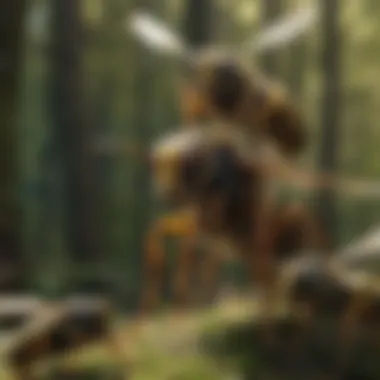

Ants and Their Aggressive Strategies
Ants are known for their structured colonies and complex social behaviors, often exhibiting aggressive strategies akin to those seen in wasps. For example, some ant species, like fire ants, will aggressively defend their territory and show cooperative aggression in the process. When disturbed, they can swarm and deliver multiple stings, which is a tactic similar to some wasps, enhancing their defense through cooperation.
However, not all ants are aggressive. Some species prioritize a non-confrontational approach, utilizing avoidance tactics and fast retreat when threatened. This variation informs researchers about the spectrum of aggression within the Hymenoptera order.
Wasps and ants both display social structures that can influence their aggressive responses. Their interactions with both each other and other species illustrate a complex web of behaviors driven by evolutionary pressures. Thus, comprehending these behaviors forms the foundation for controlling and managing human-wasp encounters effectively.
Common Myths About Wasps
Understanding common myths about wasps is crucial for dispelling fear and misinformation. In a world where these insects are often misunderstood, separating facts from fiction can foster a more informed perspective. Addressing misconceptions allows people to view wasps not just as pests, but as important ecological players. These myths shape human interactions with wasps and influence management strategies. Knowledge of the realities of wasp behavior can promote safer coexistence.
Myth: All Wasps are Aggressive
A prevalent myth is that all wasps are inherently aggressive. This belief likely stems from the encounters many people have when wasps feel threatened. Indeed, certain species, like the yellow jacket, can exhibit aggressive behavior when defending their nests. However, not all wasps share this trait. For instance, solitary wasps typically do not pose a threat to humans. These species often focus on their roles in pest control, contributing positively to ecosystems.
Identifying different types of wasps can significantly alter perceptions. Wasps such as the paper wasp are generally more docile. They often engage in beneficial activities, like pollination. Understanding this diversity helps mitigate unwarranted fears. It is crucial to approach wasps with caution rather than outright fear. Recognizing that aggression is not a universal trait can lead to better coexistence and prevent unnecessary harm to these insects.
Myth: Wasps are Useless
Another common myth is that wasps serve no purpose in nature. This notion is wholly incorrect. Wasps play multiple essential roles within ecosystems. As predators, they help control pest populations, thus benefiting agriculture and reducing the number of harmful insects. Many wasps also participate in pollination, a vital process for the reproduction of numerous plants.
The ecological contributions of wasps extend beyond pest control. Some species assist in the decomposition process by breaking down organic matter, which enriches soil health. This importance is often overlooked. By understanding their roles, a more balanced view of wasps can develop, highlighting their significance in maintaining ecological balance.
"Wasps are not just aggressors; they are also pivotal to ecological health, aiding in pest control and pollination."
Awareness of these myths leads to appreciating the contributions of wasps. This acknowledgment can reshape attitudes, fostering positive interactions with this insect group. By educating individuals about the roles of wasps, society can move toward a more respectful relationship with these creatures.
Human-Wasp Interactions
Human-wasp interactions form a critical area of study due to their implications for public safety, ecological balance, and the maintenance of biodiversity. Understanding these interactions helps demystify wasps and their behavior, contributing to more informed coexistence strategies. Humans often associate wasps with aggression, driven by fear and lack of understanding. Knowledge in this regard can mitigate unnecessary panic and promote a deeper appreciation of wasps' ecological roles.
Understanding Human Fears
Fear of wasps is a prevalent sentiment. This fear is often grounded in the anticipation of painful stings or aggressive encounters. Factors influencing this fear include personal experiences, cultural beliefs, and societal narratives. For instance, an individual who has been stung may develop heightened anxiety when in proximity to these insects. In reality, most wasps do not seek to sting unless they feel threatened or provoked. Their primary objective is usually related to foraging for food or caring for their nests.
Addressing human fears involves education. Increasing awareness about wasps’ behaviors can help alleviate anxiety.
- Common misconceptions include:
- Wasps always attack in swarms when disturbed.
- All wasps are aggressive and inclined to sting.
- Wasps have no beneficial role in the ecosystem.
Greater awareness can lead to reduced fear and better strategies for managing encounters.
Accidental Interactions and Stings
Accidental interactions between humans and wasps often occur during outdoor activities such as picnics, gardening, or hiking. People can inadvertently provoke wasps, leading to stings that are both painful and potentially hazardous for those with allergies.
Factors Contributing to Accidental Interactions:
- Food Sources: Wasps are attracted to sweet foods and drinks. Leaving food uncovered can lead to wasps inadvertently coming into close contact.
- Nesting Sites: Unknowingly getting too close to a wasp nest can result in defensive stinging behavior.
- Movement: Sudden movements can provoke a defensive reaction, as wasps may perceive them as threats.
- Time of Year: Wasps tend to be more aggressive later in the summer or early fall when food sources are scarce.
For mitigation, individuals can adopt some preventive strategies:
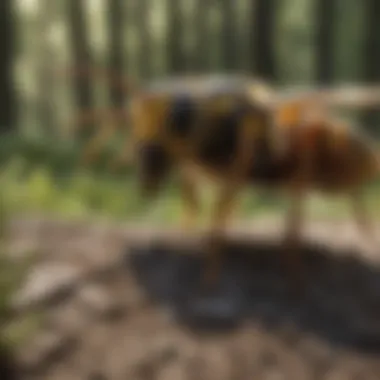
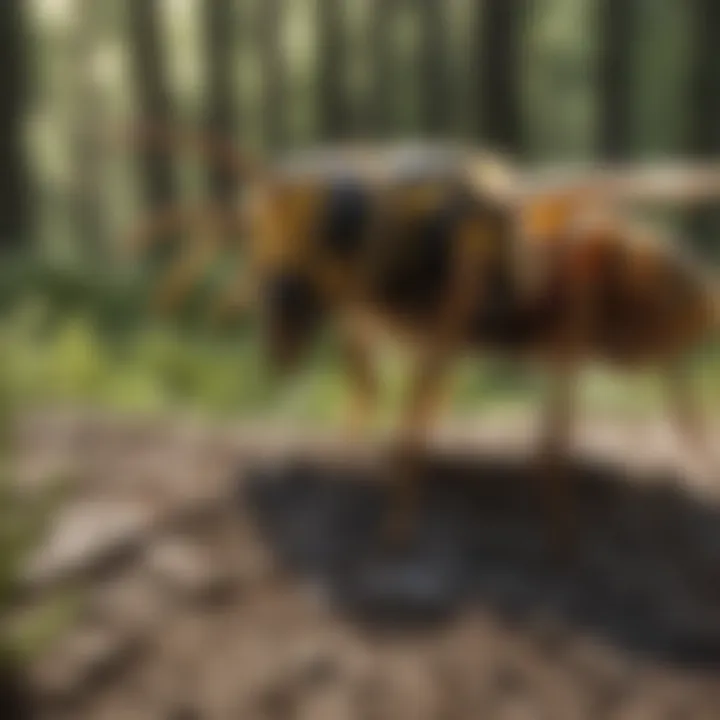
- Keep food covered outdoors.
- Avoid wearing bright colors or floral patterns.
- Be cautious when working in gardens where wasps may nest.
"Understanding the natural behavior of wasps can ease fears and promote safer interactions."
In summary, human-wasp interactions are complex and require a nuanced understanding. Recognizing fears and minimizing accidental encounters can pave the way for more harmonious relationships with these often-misunderstood insects.
Management and Mitigation Strategies
The management and mitigation of wasp-related issues is crucial, especially for those who work or spend time in woodland ecosystems. Understanding these strategies can help minimize negative interactions with wasps while respecting their role within the environment. In this section, we will discuss preventive approaches and safe methods for removing nests, offering insights for forestry professionals and academics.
Preventive Approaches
Preventive measures are the first line of defense against wasp aggression. Implementing these strategies can significantly reduce the likelihood of encounters.
1. Food Management
Wasps are often attracted to food sources. Keeping picnic areas and outdoor dining spaces clean is essential. This includes proper disposal of food waste and covering food items when not in use.
2. Nest Location Awareness
Being aware of potential nesting sites in the vicinity is critical. Common nesting locations include:
- Under eaves of buildings
- Hollow tree trunks
- Soil cavities
- Undeveloped areas
Regular inspections can help identify these nests before they become a problem.
3. Natural Deterrents
Using natural repellents may help to keep wasps at bay. Certain essential oils, such as peppermint or clove oil, can be effective in deterring wasps when sprayed in areas where they are likely to gather.
These approaches will not guarantee the absence of wasps, but they can greatly minimize the risk of aggressive encounters.
Safe Removal of Nests
When preventive measures fail, and the presence of wasps becomes a concern, safe removal of their nests should be the next step. This task must be approached with caution to minimize the risk of stings.
1. Timing
The best time to remove a nest is during early morning or late evening when wasps are less active. This reduces the chance of aggressive behavior during the removal process.
2. Protective Gear
Wearing appropriate protective clothing is essential. Long sleeves, pants, and gloves made of thick material can offer protection from stings.
3. Professional Help
In many cases, contacting pest control specialists is advisable. Professionals have the training and equipment necessary to safely remove wasp nests without putting themselves or others at risk. They can also provide insight into preventing future infestations.
"Understanding how to manage wasps is important not only for safety but also for the ecological balance in our environment."
In summary, both preventive strategies and safe nest removal techniques are essential elements in effectively managing wasps and their aggressive behavior. By incorporating these methods, individuals can foster an environment that respects wasps while reducing the risk of harmful interactions.
Epilogue
The conclusion serves as a vital summarization of the topics explored in this article, closing the loop on the intricate relationship we share with wasps. It emphasizes the need to comprehend their behavior and ecological roles, inviting readers to appreciate these creatures rather than fear them. A thorough understanding of wasps not only enriches one’s knowledge about woodland ecosystems but also aids in effective interactions with these insects.
Recap of Key Points
In the body of this article, several crucial points were highlighted:
- Understanding Wasps: Wasps inhabit diverse ecosystems, playing significant roles in pollination and pest control.
- Behavioral Traits: Their aggression can be triggered by environmental factors, disturbances, and competition for resources.
- Comparison with Other Hymenopterans: The differences in aggressive strategies among wasps, bees, and ants underscore their unique adaptations.
- Common Myths: Dispelling myths surrounding wasps helps in reducing unwarranted fears.
- Human Interactions: Proactive engagement is essential to minimize accidental encounters or stings.
- Management Strategies: Effective methods for wasp nest removal and preventive measures were discussed to enhance safety.
These elements combine to encourage a balanced perspective towards wasps, recognizing their importance in our ecosystem.
Encouraging Respect for All Species
Respecting all species, including wasps, is crucial for maintaining biodiversity. Each species contributes to the balance of ecosystems. Wasps, despite their fearsome reputation, are essential predators and pollinators. Learning to coexist is favorable for both humans and the environment.
It is vital to educate communities about the beneficial roles that wasps have. Fostering an appreciation for these creatures can lead to more informed decisions when it comes to management and conservation efforts. By recognizing their contribution, people may come to see wasps not as threats but as vital parts of their ecosystem.
"Understanding the ecology of all species forms the foundation of respect and careful stewardship of nature."







